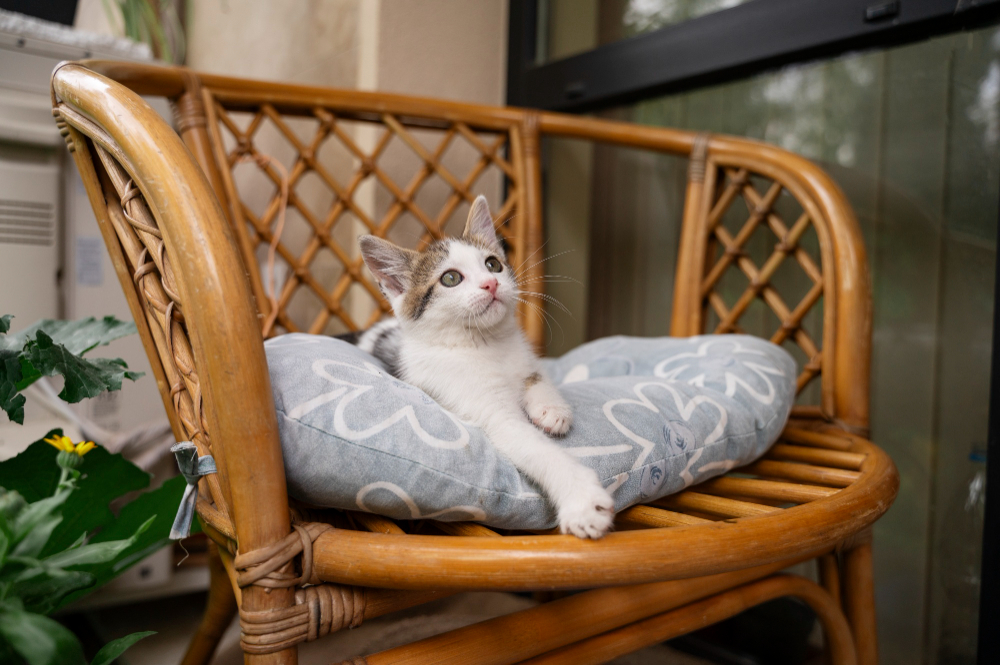How to Keep Cats Off Outdoor Furniture?

Outdoor furniture is meant to provide comfort and relaxation while enjoying the outdoors. Cats tend to make themselves comfortable on outdoor furniture as well. Their claws and fur can cause damage to the furniture and make it unappealing for human use. You may love your feline friend, but allowing them to use your outdoor furniture can be frustrating. So, how to keep cats off outdoor furniture? Here are some tips to help deter your cat from using your outdoor furniture as their lounging spot.
Understanding Your Cat’s Behavior
Cats are curious and territorial creatures. They have an instinct to explore and mark their territory. Outdoor furniture, being in an open space, can be especially appealing for them to do so. Cats also like to scratch and stretch, which leads them to use outdoor furniture as a scratching post.
Additionally, cats are attracted to soft and comfortable surfaces, making outdoor furniture an ideal spot for them to nap. Understanding these behaviors can help you develop effective solutions to keep cats off furniture.
Potential consequences of cats on outdoor furniture
Cats on outdoor furniture can cause a range of problems.
Scratches from their claws can damage the furniture and make it unsightly. Their fur can also get stuck in the fabric, making cleaning difficult. Cat urine and feces can leave unpleasant odors and pose hygiene concerns for human use. If you have guests over, their allergies may be triggered by cat fur and dander on the furniture. These consequences can be frustrating and costly, but with the right approach, you can prevent them from happening in the first place.
Methods to Keep Cats Off Outdoor Furniture
Here are some effective methods you can try to keep cats off patio furniture:
Provide cat-friendly alternatives
One of the best ways to keep cats off outdoor furniture is by providing them with designated areas or furniture. This allows them to satisfy their natural instincts without damaging your outdoor furniture.
Consider creating a small shaded area in your yard with a soft bed or mat for your cat to lounge on. You can also provide them with a scratching post or cat tree to satisfy their need to scratch and stretch. Place these cat-friendly alternatives in areas away from your outdoor furniture to prevent them from being tempted to use it.
Use physical barriers
Physical barriers are another effective way to keep your cat off outdoor furniture. You can use covers, netting, or barriers that physically block their access to the furniture. These can be especially useful for larger pieces of outdoor furniture such as sofas or tables. Another option is to cover the furniture with aluminum foil, which cats dislike due to its texture.
You can also consider using plastic carpet runners with the nub-side up, sandpaper, or tin foil on outdoor furniture surfaces. These materials are uncomfortable for cats to walk on and can discourage them from using the furniture.
Employ scent deterrents
Cats have a strong sense of smell and are sensitive to certain scents. Utilizing scents that cats dislike can be an effective way to keep them off your outdoor furniture. These scents include vinegar, eucalyptus, lemongrass, peppermint, lavender, and citrus essential oils. You can create a homemade spray using these scents mixed with water and spray it on the furniture.
Be cautious when using essential oils, as they may harm cats if ingested. Use small amounts and dilute them properly with water before spraying them on the furniture.
Try commercial repellents
There are also commercially available cat repellents to deter cats from outdoor furniture. These products typically contain natural ingredients such as citronella, pepper, or other strong scents that cats dislike. Make sure to read the labels and choose a product that is safe for your cat and your outdoor furniture’s materials.
Some repellents come in sprays or granules that you can apply directly onto your furniture. Others may require you to mix with water before use. Always follow the instructions on the product and use them as directed for optimal results.
Read Also: Best Sanders For Furniture
Use mothballs sparingly
Mothballs contain a strong scent that cats and other critters dislike. You can use them as a deterrent by placing them near your outdoor furniture. However, it is important to exercise caution when using mothballs, as they can harm cats and humans if ingested. Keep them out of reach of your cat, and do not use them in areas where children or other pets may come into contact with them.
Consistency and training
Consistency is key when training your cat to stay off outdoor furniture. It may take some time and patience, but your cat can learn to avoid the furniture with consistent reinforcement.
Encourage positive behavior by rewarding your cat with treats or praise when they use their designated areas or furniture. Redirect them to these areas whenever you catch them trying to use the outdoor furniture. When your cat does use the furniture, firmly say “no” and remove them from the area. This will help them understand that it is not acceptable behavior.
Other training techniques, such as using a spray bottle to mist your cat when approaching the furniture lightly, can also be effective.
Implement visual deterrents
Visual deterrents are another way to discourage cats from using outdoor furniture. Placing shiny objects or reflective surfaces near the furniture can startle and deter cats. You can also hang wind chimes or use motion-activated noise devices that will make a noise when cats come near the furniture.
The key is to keep these visual deterrents constantly changing so your cat does not become accustomed to them over time. This will make them more effective in keeping cats away from the furniture.
Apply sticky surfaces
Cats dislike walking on sticky surfaces, making this an effective way to keep them off outdoor furniture. They will quickly learn to avoid the furniture if their paws get stuck on double-sided sticky tape or adhesive mats placed on the surfaces. These materials are safe for cats and can easily be removed when not needed.
Double-sided sticky tape or adhesive mats can be placed on outdoor furniture surfaces to discourage cats from scratching or jumping onto them. The stickiness will deter them from using the furniture, and they will eventually learn to avoid it altogether.
Install motion-activated sprinklers
Motion-activated sprinkler systems are an effective way to startle and deter cats from using outdoor furniture. They work by sensing motion and spraying a small amount of water as a deterrent. These sprinklers are safe for cats and furniture and can be easily installed near the furniture.
Use a motion-activated sprinkler specific for deterring animals, as some may be too powerful and potentially harm your cat. You can also adjust the sensitivity and spray range to target specific areas where your cat likes to go. This will help to reinforce the behavior that outdoor furniture is off-limits.
Create unattractive surfaces
Finally, you can create unattractive surfaces on your outdoor furniture to discourage your cat from using it. This could include materials such as plastic carpet runners with the nub-side up or tin foil on surfaces. Cats find these materials uncomfortable to walk on and will avoid using the furniture.
Sandpaper can also be effective in creating an unattractive surface for cats. Secure it tightly onto the furniture to prevent your cat from tearing or pulling it off. With consistent reinforcement, your cat will learn that outdoor furniture is not a desirable place for them to be.
Combining these methods can effectively deter cats from using outdoor furniture and keep them safe and happy.
Read Also: How To Remove Stains From Rattan Furniture
Additional Tips
- Create a comfortable and designated area for your cat to play, sleep, and scratch. This will provide an alternative to outdoor furniture.
- Regularly trim your cat’s nails to prevent damage from scratching.
- Keep outdoor furniture covered when not in use to reduce temptation for cats.
- Be patient and consistent with training, as it may take time for your cat to learn new behaviors.
- Consult your veterinarian for concerns or questions about using certain repellents or training techniques.
Frequently Asked Questions
There are several ways to keep cats off chair cushions. One option is to use a spray containing natural ingredients such as citrus or lavender, known to be repulsive to cats. You can also try placing double-sided tape on the cushions or using a motion-activated deterrent device.
Cats generally dislike strong scents such as citrus, eucalyptus, and lavender. You can use these scents to your advantage by spraying or placing fresh herbs around the furniture you want to protect.
To prevent cats from peeing on outdoor furniture, there are a few steps you can take. First, ensure the area is clean and free of lingering scents that may attract cats. Next, you can use a repellent spray or double-sided tape on the furniture. Providing your cat with a designated outdoor litter box may also help.
Several natural remedies can help keep cats away from certain areas. Some options include using citrus peels, coffee grounds, or vinegar as a deterrent. These scents are unpleasant to cats and can help keep them away from your desired location.
The safety of sprays on cats depends on the ingredients used. It is immoral ways to read the label and avoid using products containing toxic ingredients that could harm your cat’s health. Alternatively, you can make your cat repellent using natural ingredients safe for cats.
One simple and effective homemade cat repellent can be made by combining equal parts of water and white vinegar in a spray bottle. Another option is to mix lemon juice with water and spray it on the desired areas. Plant herbs like lavender, rosemary, or rue around your outdoor space to naturally repel cats.
Conclusion
Cats are wonderful and loving creatures that make great pets. However, if given the chance, cats can also make a mess of our outdoor furniture. In this guide, we have discussed various methods on how to keep cats off outdoor furniture.
Following these tips, you can protect your outdoor furniture while maintaining a healthy and happy relationship with your feline friend.
One important thing to remember is always to provide an alternative for your cat to scratch or climb on. Cats have instincts to scratch and climb, so provide them with appropriate outlets for these behaviors.





